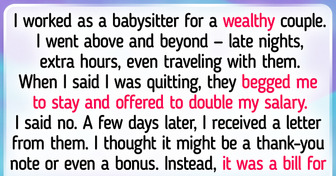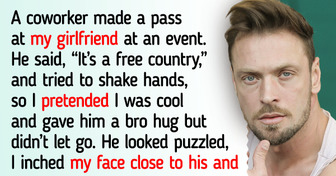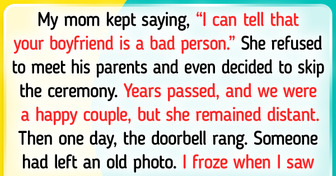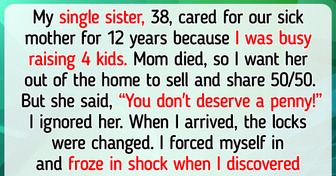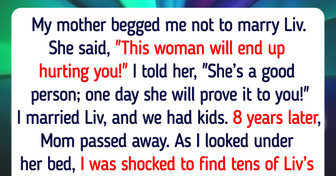«You Ain’t Got the Body to Pull It Off», Stunning Selena Gomez Deemed Too Big For Her Tight Dress

Our homes contain many things that can serve as equipment for staging exciting science experiments for our kids. Well, maybe not just for kids. A few discoveries of the ’’why have I never noticed this before?!’’ variety won’t pass by without interest from grown-ups, as well!
Bright Side offers you a selection of awesome experiments that will entertain your friends and kids.
What you’ll need: Salt, water, one glass of vegetable oil, a few food colourings, a large transparent glass or jar.
Experiment: Fill the large glass 2/3 full of water. Pour the vegetable oil into the water. The oil will float on the surface. Add food colouring. Finally, slowly poor one teaspoon of salt into the glass.
How it works: Because oil is lighter than water, it floats on the water surface. When salt is added to the glass, the salt grains drag the oil to the bottom. Then, once the salt grains have dissolved, the particles of oil are free once again to rise to the surface. The food colouring helps to make the experiment visually exciting.
What you’ll need: A container filled with water (such as a bath tub or a washbowl), a flashlight, a mirror, and a sheet of white paper.
Experiment: Fill the container with water and place the mirror at the bottom of the container. Aim the beam of light of the flashlight at the mirror. Make sure that it reflects off the surface of the mirror onto the sheet of paper. If done correctly, a rainbow should appear on the paper.
How it works: As it passes through water, a beam of light splits into its component colours. As a result, a rainbow appears.
What you’ll need: A tray, a small plastic bottle, sand, food colouring, baking soda, vinegar.
Experiment: Use clay and sand to mould a volcano shape around the small plastic bottle — to add ambience to the experiment. To make it erupt, pour two tablespoons of baking soda into the bottle, then add a quarter of a glass of warm water. Put in some food colouring. Finally, add a quarter of a glass of vinegar.
How it works: When soda comes into contact with vinegar, a violent reaction occurs, causing an emission of water, salt and carbon dioxide (CO2 bubbles being the force that drives the contents of the ’’volcano’’ upwards).
What you’ll need: Salt, water, a piece of wire.
Experiment: To grow crystals, you need to prepare a super-saturated salt solution. The concentration of salt should be such that, if you add any more, it won’t dissolve. Make sure that the solution remains warm. To make the process run more smoothly, you’d better use distilled water. When the solution is ready, pour it into a new container — to get rid of dirt traces that are always present in salt. Now you can take a piece of wire, make a small loop at one end, and lower it into the solution. Put the container in a warm place, so that the liquid won’t cool down right away. After a few days, beautiful salt crystals should grow on the wire. If you get the hang of it, you can grow quite large crystals and even make patterned handicraft by twisting the wire into various shapes.
How it works: As water cools down, the solubility of salt decreases. This leads to precipitation, with salt crystals forming on the container walls and on the wire.
5. Dancing coin
What you’ll need: A bottle, a coin large enough to cover the bottle’s mouth, water.
Experiment: Place the empty uncapped bottle in the freezer. Keep it there for a few minutes. Take the coin and dip it in water. Remove the bottle from the freezer and put the coin on top of the bottle, so that it covers the bottle’s mouth. After a few seconds, the coin should start jumping on the bottle’s rim, accompanied by curious clicking noises.
How it works: Hot air takes up more space than cold air. When you take the bottle out of the freezer, the air inside the bottle begins to warm up and expand. It rushes out through the bottle’s mouth, making the coin ’’dance’’.
What you’ll need: Whole milk, food colourings, liquid detergent, cotton swabs, a plate.
Experiment: Pour some milk onto a plate. Add a few drops of food colouring. Take a cotton swab; dip one end of it into liquid detergent. Next, press the detergent-covered swab to the centre of the plate. The milk will begin to swirl, forming colourful patterns.
How it works: The detergent reacts with the milk’s fat molecules, setting them in motion. That’s the reason why using fat-free milk for the experiment just won’t do!
What you’ll need: A ten dollar banknote, tweezers, matches (or a lighter), salt, an ethanol and water solution (50% ethanol / 50% water).
Experiment: Add a pinch of salt to the ethanol and water solution. Dip the banknote into the solution, making sure that it’s completely soaked. Use tweezers to retrieve the banknote from the solution. Allow excess liquid to drain from the banknote. Set fire to the banknote and watch it burn without burning up.
How it works: Burning ethanol produces water, carbon dioxide and heat (energy). When you light up the banknote, only the spirit part of the solution burns up. The resulting heat is not enough to evaporate the water soaked up by the paper banknote. In the end, the flame goes out by itself, leaving the note undamaged, if slightly damp!
What you’ll need: Two egg cartons holding ten eggs each, a garbage bag, a bucket of water, a bar of soap, and — a few trusty friends!
Experiment: Spread the garbage bag on the floor and put two egg cartons on it. Check the contents of the cartons and replace any cracked or broken eggs. Make sure that all the eggs are facing the same way inside the carton — either the pointy, or the rounded end upwards. Place one bare foot on the nearest carton, making sure that your weight is spread evenly across all ten eggs. You may want to ask your friends to steady you, before putting your other foot on the second carton. If you do everything right, you’ll be able to stand and even walk on eggs. To ensure that one careless movement doesn’t turn a brilliantly-planned experiment into a wacky cooking show, place a thin plank or tile over the eggs. This way, nothing will spoil your stroll to scientific glory!
How it works: Eggs are easy to break — everyone knows that. But, in reality, an eggshell is very tough and can withstand serious weight. An egg’s ’’architecture’’ is such, that, provided the pressure is applied evenly, the tension is distributed across the entire shell and the egg remains intact.
What you’ll need: An empty jar, drops of food colouring, warm water, 3 tablespoons of vegetable oil.
Experiment: Fill the jar about 3/4 full with warm water from the tap. In a separate bowl or dish, place 3 tablespoons (approx) of vegetable oil. Carefully put drops of food colouring into the oil. Mix it all gently with a fork, just enough to disperse the food colouring a little bit. You’ll notice it doesn’t mix with the oil, it just breaks up into smaller dots. Now pour the oily and colour mixture into the warm water in your jar. Watch as the coloured drops sink down into the water and mix together creating a firework effect.
How it works: The food colouring will dissolve into the water, but the oil won’t. By mixing the oil and food colouring together first, you slow the mixing process that would normally happen with the water and the food colouring. The food colouring drops down into the water (because it is denser than the oil) while the oil stays on top of the water (water is also denser than oil). When the food colouring eventually starts to mix with the water, it creates a tiny explosion, like a firework.
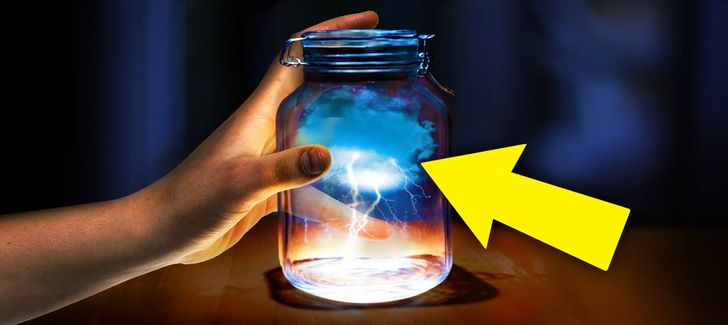
What you’ll need: a one gallon size glass jar, matches, a rubber glove, a rubber band, flashlight or lamp, food coloring, and water.
Experiment: Pour boiling water into the jar — just enough water to cover the bottom of it. Swirl the water around inside so that it covers the sides of the jar. Put the rubber glove wrist around the mouth of the jar with the fingers pointing downward and put your hand in the glove. Once your hand is in the glove, move it upward so that you pull the fingers of the glove up. You’ll notice that nothing happens to the water. Take the glove off the jar for just a moment, light a match and drop it in the jar. Stretch the glove back over the jar, with the fingers pointing down. The water at the bottom of the jar will put out the match, and smoke will form inside the jar. Slide your hand into the glove and pull it outward again.This time, a cloud will form in the jar. When you put your hand back inside the glove, the cloud will disappear. This will last for 5-10 minutes. When you shine a flashlight at the jar, you can see the clouds better.
How it works: The air is full of warm water vapor molecules inside the jar. The glove compresses the air because the glove takes up some of the space inside the jar. Pulling the glove fingers out of the jar releases some space in the jar and the air cools.The smoke from the match acts as a vehicle to which the water molecules can attach. They stick to the smoke particles, condensing into cloud droplets. If you want colored clouds, add a few drops of food coloring to the water in the bottom of the jar before adding the match.
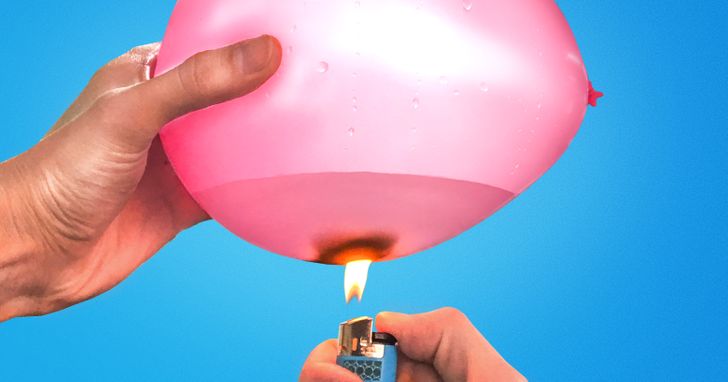
What you’ll need: a balloon, water, a lighter or candle.
Experiment: Fill the balloon to the top with water and then blow it up with air. Then tie off the balloon and get ready for the next step. Hold the water-filled balloon at the top while you slowly lower it over the lighter and watch as people start to run. Everyone knows that it’s going to pop, but for some strange reason it doesn’t. If you’re very brave, you can actually allow the flame to touch the bottom of the balloon, but it still doesn’t pop.
How it works: The reason a balloon filled with air pops when you put it over a flame is because the rubber of the balloon gets very hot and weak and then breaks. When you fill a balloon with water instead of air, the water absorbs most of the heat, so the rubber doesn’t get very hot.
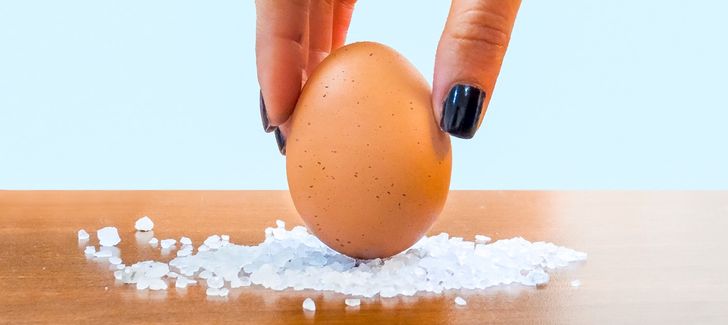
What you’ll need: a small amount of salt, an egg.
Experiment: Make a small pile of salt on a hard and smooth surface. Place an egg carefully on the salt. Then blow the excess salt away. Voila! You’ll get an egg balancing on its end!
How it works: The trick is that the egg is supported by unseen salt crystals which make a good base for the egg to balance on.
What you’ll need: A bowl or large glass, tap water, table salt, an egg.
Experiment: Fill the bowl or glass about 2/3 full with tap water. Drop the egg carefully into the bowl and observe it sinking to the bottom. Remove the egg and add salt, I added about 5 tablespoons then tried it again, adding more and more until it floated.
How it works: Objects sink in water when they are more dense than the water, by adding salt we make the water more dense, once the water is denser than the egg it floats. You could also try other objects and see what else you can make float.




